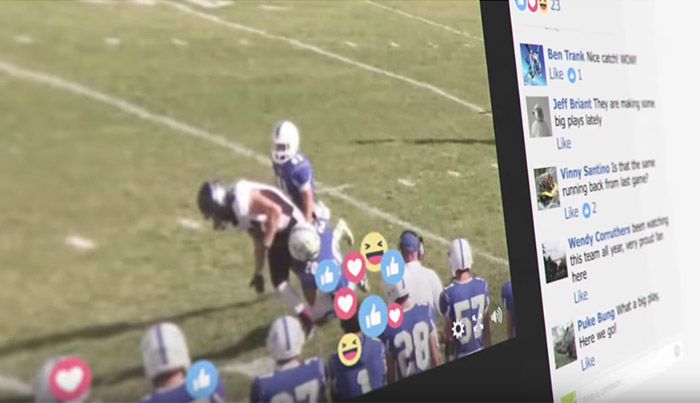Just the other afternoon, someone in the Epiphan kitchen brought up a great question: what do you think of the future of live streaming video? What is going to be the next big thing in live video? That sparked a lively lunchtime speculation discussion involving holograms and (inevitably) space and time portals. But in all seriousness, that really got us wondering: what might the future of live streaming look like 5 years from now?
Yes, live streaming is big right now (we say that in every article, but only because it’s true). It is both more accessible to the viewer and easier to produce for the creator than ever before. Landline and mobile internet provide more than enough bandwidth for a smooth live video experience. Considering the encompassing reach of current live video trends, it’s fair to assume that it will continue to grow and evolve.
Readily available infrastructure aside, people love the idea of live video. A live stream is a perfect opportunity for a two-sided human interaction, and a real, genuine connection through their devices. The mad popularity of live streaming apps like Periscope and Snapchat supports this idea. Live video has a certain relevance; it’s exciting in the fact that it’s a bit unpredictable, unfolding before your very eyes.
Current trends in live streaming
Social media dominion
We’ve witnessed the rise of live video journalism on social media, capturing life-changing events in the most polarized parts of the world. We’re seeing gaming and eSports live streams constantly break viewership records. Many creators today are even making a living going live. Thousands of houses of worship are using simple encoders like Webcaster X2 to live stream their services and connect many people in prayer and in spirit.

Live video apps like Periscope and Snapchat skyrocketed in popularity, especially among younger audiences. Sending live video clips as a method of communication with peers feels absolutely natural to this generation. Perhaps a just decade ago, users felt awkward going on a video call, or even felt embarrassed watching someone else’s poorly produced live video. We are now more forgiving (and much more appreciative!) of the more natural, genuine human behavior on live media.
Marketing media of choice
Live streaming video is reinventing the way brands think about marketing and e-commerce. Live video is already becoming an essential marketing tool that can help brands grow significantly.
Brands are more willing to invest in live video more than ever: a 2017 study conducted by Brandlive and IBM reported that about 95% of respondents shared that live video will be an important part of their 2018 marketing mix, with 25% stating that “live content will be a top priority, edging out pre-recorded video”. Over 50% said that their budgets for live content will increase compared to prior year.

A company is using live video to do a product launch
We see brands going live regularly on social media and other CDNs. We see them bring in experts and influencers, who not only promote the product, but also interact with the viewers, answer questions, share knowledge, and help build a community around the brand. Live Q&A sessions, tutorials, access to live product launches, exclusive behind the scenes streams – all of these are tools that help build real trust between a company and their customers.
Companies are getting better and better at using live video to bring down those unapproachable corporate walls, adding an authentic human interaction to the mix.
Internal corporate communications booster
In business relations, companies are using live video to help strengthen their corporate culture and build solid relationships amongst employees. Internal company addresses, team meetings and employee training are done through live video, increasing engagement and productivity. That same study by Brandlive and IBM, found that live video “is highly effective in keeping employees connected across regional locations and varied time zones.”
This is exactly why the company Cisco acquired a videoconferencing startup called WebEx way back in 2007. They successfully foresaw a future where live streaming is helping people to communicate better.
Education empowerment
Live streaming is enhancing the way we learn. Conferences, talks, and events are being live streamed on regular basis. Universities like Harvard and Stanford are taking advantage of live lecture streaming. This gives their students access to knowledge anytime, anywhere, taking down barriers to education. Consequently, students who may not otherwise be present at the lecture are now able to partake.
Our forecast for the future of live streaming video
Many of our predictions are simply extrapolations of current trends, while others, as we believe, will emerge through combining live streaming with other current popular trends and technologies.
Further marketing and e-commerce involvement
Just like printed and video ads before it, we will see live video start to ingrain deeper into marketing, becoming its cornerstone tool. We will see more companies going live with their own shows, introducing their own brand ambassadors and trusted experts (much like we do on Live @ Epiphan). More live events will be used as “see-now-buy-now” eCommerce platforms for a live online shopping experience. As a result of frequent and intentional use in marketing, live video production will become a regular part of marketing education curriculum. New and better tools for measuring ROI of live streaming campaigns will become available.

Tmall Collection 2017: Where Fashion Meets Entertainment
Video customer support
Live Q&A sessions as a way to receive help immediately and from real, knowledgeable people will become more and more widespread. Similarly to current over-the-phone customer support, live video customer support centers will emerge. Receiving support with real-time visual aids will help solve issues faster.
Machine learning in live streaming
Machine learning is the latest digital transformation that helps streamline and personalize the user experience for all kinds of technology. This type of computing algorithm essentially “learns” what yields a positive result and what doesn’t, and continuously improves itself based on this collected data. There are many opportunities for machine learning applications in live video scenarios of all sizes, including large multi-camera events, smaller single-camera live streams, and even lectures at educational institutions.
Computers will be able to learn certain cues (lighting, face and speech recognition, etc) in order to automate live switching, recording, and even adding lower thirds. For example, “smart” live video will be able to automatically start the stream when it recognizes a specific voice or person has appeared on stage. This technology can even track the presenter across the stage, keeping the focus on them. Once the stream is over, the technology can automatically generate and upload a highlight reel of the event based on cues like audience applause and lighting.
The potential for AI and machine learning is huge, and there are many specific examples of how it can be applied. Be sure to check out our article on machine learning in live video production for all the full story.

Technology called ClearLecture allows for easy clean-up of images to remove view obstructions.
Live stream aggregators
With an increased amount of simultaneous live video traffic, internet users will have a hard time keeping track of all the events. This problem may be solved with live content aggregation services that will categorize streams, help viewers decide what to watch, and even schedule and set reminders for upcoming streams.
In closing
Cisco predicts that by the year 2021 video will account for 82% of all internet traffic, and live video will account for 13% of all internet video traffic by 2021. In case thirteen percent doesn’t sound like much, just keep in mind that even today, about half a million hours of video content is uploaded every day to YouTube alone.
We see a future where live video is the standard for remote communication all across the board. In the near future, live streaming video will have the strongest effect on the way we learn, collaborate, market products and services, consume advertisements and entertainment, and receive tech support.
The key purpose of live streaming is to ultimately help us understand each other better despite being physically far away. Our mission here at Epiphan is to promote the democratization of live video production. We believe that live video is the new form of authentic interactive human dialogue and we want to help make it more accessible through our products and services.

